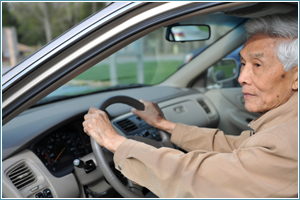Your Car :: Getting a Good Fit
With a growing senior population and advancing technology, automakers are designing vehicles geared towards the needs of senior drivers. These new models have enhanced features, including:

- Clearer dashboard displays
- Wider doors
- Easier seat controls
- More precise seating adjustments
- Night vision technology
- Adjustable pedals
When searching for a new vehicle, look for ones that add to your comfort and control and offset any loss you have experienced in strength or visibility. You could consider:
- Automatic transmission
- Power windows and door locks
- Low door threshold - Makes vehicle entry and exit easier
- Four doors - Requires less strength to open and close doors than two-door models, which have longer, heavier doors
- Power steering
- Dynamic stability control - A feature that helps prevent loss of control in a turn, enabling you to compensate for slower reaction times and make quick corrections
- Power anti-lock brakes - Prevents wheels from locking during emergency breaking
- 6-position adjustable seats - Makes it easier to enter and exit vehicles and adjust seats for leg room, and it allows you to obtain a line of sight above the steering wheel
- Heated seats with lumbar support - Can assist with back pain
- Telescoping or tilting steering wheel - Ensure that you can position yourself at least 10 inches from the front airbag, and helps you alleviate neck and shoulder pain
- Thick steering wheel - Requires less hand and wrist strength to grip and handle
- Steering wheel covers - Improves your grip to compensate for arthritis in your upper body
- Automatic day/night (electrochromic) rearview mirror
- Rear window defroster
- Power-adjust side mirrors - Easier to adjust for drivers with limited strength and arthritis
- Large, wide-angle mirrors - Helps you compensate for limited range of motion or difficulty turning to check blind spots
- Keyless entry and keyless ignition mounted on the dashboard - Helps avoid difficulty that can occur by turning a key in the lock or ignition
- Dual front air bags
- Daytime running lights - Make it easier for others to see you
- Amber turn signals
- Un-tinted windshield
- Easy-to-reach controls
- Large and well-lit dashboard controls and buttons - Easier to use than knobs
- Visors and extendable sun visors - Helps you adjust to and prevent glare
- Tire Pressure Monitoring System - Alerts you when tire pressure is low

The visibility of your vehicle on the road is also important. Studies show that the most visible vehicles on the road have light, single-tone paint jobs. Industry analysts report the safest colors to be greenish yellow, cream, yellow and white. The least safe colors are red and black
Larger vehicles tend to be easier for senior drivers to get in and out of, thanks to more head room, leg room, and higher seats.
But only you can determine how comfortable you feel in a car. So take a test drive!
- As you get in and out of the vehicle, notice whether you have to bend uncomfortably or have trouble lifting your legs
- Behind the wheel, check thoroughly for any blind spots
- The rearview mirror should show as much of the rear window as possible
- Look over your shoulder on both sides to confirm that you can see clearly
- Adjust the seat. Assure that you can easily adjust the height and tilt
- Make sure the top of the steering wheel is no higher than the top of your shoulders
- Also check that you can steer freely. Grasp the steering wheel so your hands lay at 8 o'clock and 4 o'clock, with your upper arms resting on your ribcage. Turn the steering wheel and turn it to the left and right
- Assure that you can comfortably reach the pedals while steering, as well as the radio and temperature controls
- Confirm that there is at least 10 to 12 inches between your chest and the front airbag and steering wheel
- Try out the seat belt to make sure it fits properly. You will be wearing it every time you get in your car!
- An improperly adjusted shoulder harness that puts pressure on your neck can cause dizziness and a drop in blood pressure
- The lap belt should go across your hips, and the shoulder belt should go across your rib cage and not under your arm
- Make sure the headlights and windshield wipers work properly to enhance vision
- If you use a wheel chair or walker, be sure it can fit comfortably in your car and easily be taken in and out









